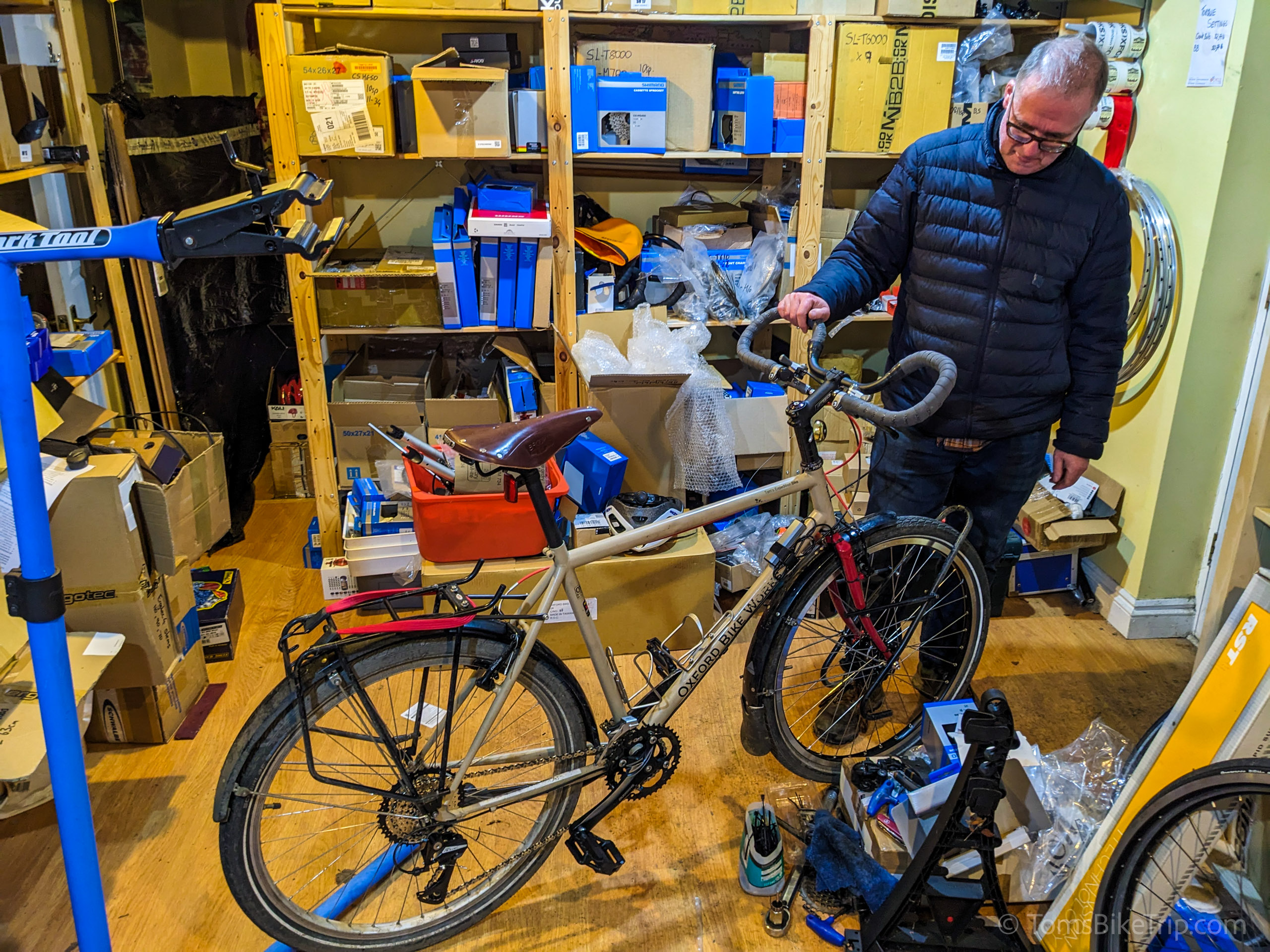Choosing Brakes For Touring Bikes
Braking systems vary in where the braking force is applied:
- Rim brakes act upon the outer wheel rim,
- Disc brakes act upon an inner metal rotor.
and in how that force is transmitted from the brake levers:
- Cable brakes transmit force through a wire cable
- Hydraulic brakes transmit force through fluid-filled hoses

Disc Brakes Vs Rim Brakes For Touring Bikes
This one is a potential rabbit hole, so I’ve written about the choice between disc brakes and V‑brakes on a touring bike in detail as part of my Touring Bike F.A.Q. series. To recap:
Both types of brake stop bikes, so the choice has little to do with functionality. The advantages of rim brakes on a cycling expedition are simplicity and serviceability. They’re standard on cheap, mass-produced “mountain bikes” the world over, meaning you’ll find parts in every bike workshop on Earth. Repairs are generally easier as components are generic and cross-compatible. Properly configured, they’re as powerful as disc brakes in all but the worst conditions.
The biggest advantage of disc brakes for cycle touring is in long-term durability, especially now the principle has been tried and tested on round-the-world tours. Simply put, disc brakes won’t gradually wear out your wheel rims, whereas rim brakes inevitably will – eventually. A secondary benefit is performance in challenging conditions. All else equal, disc brakes have more reliable stopping power in wet, muddy and/or icy conditions. You also get more precise control (aka: modulation) over braking force.
What To Know When Choosing Disc Brakes For A Touring Bike
If you go with disc brakes, ensure you choose disc calipers to match your brake levers – road and MTB parts don’t mix here. The easiest way to do this is to buy a complete brake set.
Caliper mount type and rotor size need to match frameset specifications: there are a couple of different types of fork/frame mount for disc brakes and you may need an adaptor to make your combination work.
Don’t forget that disc brakes also mean getting disc-specific hubs when you have your wheels built. Yet again, multiple disc rotor mounting systems exist (Shimano use a splined flange whereas some other manufacturers use six threadlocked Torx-head bolts against a machined mating surface), so make sure disc rotors and hubs are matched.
Finally, it can sometimes get a little crowded around the dropouts when you fit disc brakes, pannier racks and mudguards fenders together, so expect a little trial and error when fitting. Spacers, shims and extra-long bolts can all help here.
V‑Brakes vs Cantilever Brakes For Cycle Touring
On touring bikes with dropped handlebars, you will often see road-oriented cantilever brakes instead of mountain bike V‑brakes. They both act on the rim of the wheel, and they both use cables for actuation, but the mechanism is slightly different.
The key is matching the brake mechanism with the brake lever. Drop bar cantilever brake levers and calipers pull a shorter length of cable when used. Flat-bar V‑brake levers and calipers pull a longer length of cable. Both systems, if properly set up, will function equally well. Just remember that they aren’t cross-compatible.


For the ultimate expedition bike, we chose to use the V‑brake system, fitting black Shimano Deore BR-610 calipers. Since the Deore line has moved to hydraulic disc brakes, today’s equivalent caliper would be the Shimano Alivio BR-T4000, which you’ll now find listed in the ‘trekking’ category (though they were originally intended for mountain bikes).
We paired these calipers with compatible Shimano Alivio BL-T4000 brake levers for flat bars. Being British, we connected the left-hand lever to the rear brake and the right-hand lever to the front brake, which people from various other countries may find weird.
Cables were standard Shimano. We switched out the standard 90º brake noodles for flexible ones, and installed the rear brake cable with a full-length housing to reduce dirt and moisture ingress – a little workshop trick to improve longevity.
(Some builders like to spray a bit of silicone or Teflon lubricant through the housing. I would only do this if I was expecting a lot of wet or humid weather. In dust, sand and heat I prefer to run cables dry. Never use grease or oil in any case as they’ll clog up with road grime and seize.)
We fitted Shimano BR-M770 (aka: S70C) brake shoes, which are sold as a Deore XT-series upgrade, designed for severe conditions and with increased stopping power for heavy luggage loads.
These shoes feature replaceable cartridge shoe inserts (re-order code WP-Y8A298030), meaning my on-bike tools and spares kit weighs a little less. Yay! If I run out of rubber, the cross-compatible nature of V‑brakes means I’ll be able to fit any standard V‑brake shoe I can find.
Had I gone for disc brakes (since 2019, Oxford Bike Works have offered a disc-specific frameset), I would have chosen a cable-actuated mechanical disc brake that had proven itself on long distance tours.
Today, that would probably mean something from TRP; either the Spyre for drop bars or the Spyke for flat bars et al. (You’ll find these specified on plenty of commercial high-end touring bikes.)


Something to add?